HRC’s Changing Roles
The Community’s Political Action Committee
When the Human Rights Campaign Fund was started in 1980, the organization functioned as a political action committee (PAC). The original mission was to advocate for the gay and lesbian community by providing campaign contributions to politicians who promised to support gay and lesbian civil rights.
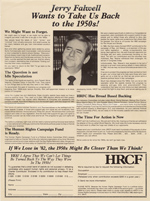 |
HRCF. Poster, “Jerry Falwell Wants to Take Us Back to the 1950s!” HRC Records. [zoom] |
The Human Rights Campaign Fund grew quickly during its early years. During the 1982 election cycle, the fund contributed $140,000 to 118 congressional candidates, 81% of whom won their races.
Sam Gejdenson was one of the first candidates to receive HRCF support. The 1982 letter shown here describes HRCF as a new PAC.
HRCF’s newsletter reflected on this early success:
The newsletter continued with praise for its members who had “correctly realized that electoral politics is a serious and costly business which demands enormous commitment, large sums of money and plain hard work.”
In 2005, donors contributed a record $35.9 million to support HRC’s varied activities, and HRC endorsed 201 congressional candidates. The average success rate has been 90%.
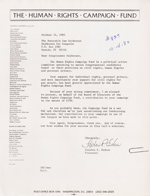 |
Steve Endean, HRCF treasurer. Letter to Sam Gejdenson. October 14, 1982. HRC Records. [zoom] |
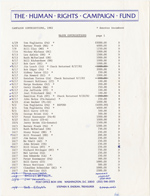 |
Human Rights Campaign Fund. Campaign Contributions, 1982. HRC Records. [zoom] |
 |
Human Rights Campaign Fund. Federal Disbursements for 1986 Elections. HRC Records. [zoom] |
Through its generous financial contributions and efforts to educate political candidates, HRCF made powerful allies on Capitol Hill. HRCF was able to correspond directly with prominent members of Congress, providing them with relevant information about gay and lesbian issues and anti-gay organizations like the Moral Majority.
Shown here, for example, are 1989 letters between Senator John Kerry, D-Mass., and the Human Rights Campaign Fund regarding anti-gay legislation proposed by Senator Gordon Humphrey, R-NH.
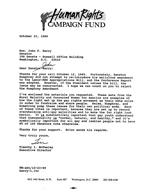 |
HRCF. Letter to John Kerry about Senator Humphrey’s anti-gay legislation. October 23, 1989. HRC Records. [zoom] |
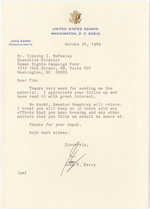 |
Senator John Kerry. Letter to Tim McFeeley about Humphrey’s anti-gay legislation. October 26, 1989. HRC Records. [zoom] |
HRCF often fought to defeat anti-gay candidates by publicizing their homophobic stance on particular legislation and by supporting their political opponents. In 1987, HRCF ran a series of advertisements against Senator Jesse Helms, R-NC, and against his hostile amendment to the Federal AIDS Research, Information and Care Act. In Senator Helms’ own words, the amendment, which did pass:
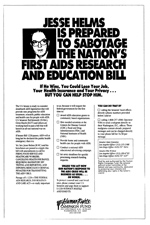 |
HRCF advertisement. “Jesse Helms is Prepared to Sabotage the Nation’s First AIDS Research and Education Bill.” November 1987. HRC Records. [zoom] |
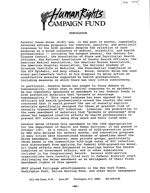 |
Human Rights Campaign Fund. Memorandum, “Senator Jesse Helms has...” November 1987. HRC Records. [zoom] |
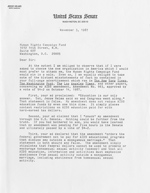 |
Senator Jesse Helms. Letter to Human Rights Campaign Fund. November 3, 1987. HRC Records. [zoom] |
In 1998, the HRC helped Tammy Baldwin become the first openly LGBT non-incumbent to win a congressional race. As this press release states, “The Human Rights Campaign took an active role in helping Tammy Baldwin both financially and by providing volunteers. HRC’s political action committee (PAC) gave Baldwin a $5,000 contribution and sent out a mailing to the 2,000 members in the district. HRC also provided two staff people to help organize HRC’s members and consult with the campaign.”
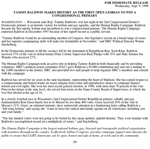 |
“Tammy Baldwin Makes History as the First Open Lesbian to Win a Congressional Primary.” September 9, 1998. HRC Web site. [zoom] | View the original HRC web page |
HRC’s endorsements haven’t been without controversy. In making its selections, HRC favors incumbents and follows a bipartisan approach. Its 1998 endorsement for the New York senate seat of Republican incumbent Al D’Amato over challenger Democrat Chuck Schumer brought a storm of protest from members. Shown here is an HRC explanation of the decision.
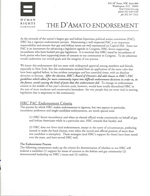 |
HRC flyer, “The D’Amato Endorsement,” 1998. HRC Records. [zoom] | Additional images: 
|
HRC showed its opposition to President George W. Bush during his 2004 re-election campaign.
This January 2005 ad targets a number of U.S. Senators who expressed homophobic views and policies.
 |
HRC. Miniature truck, “George W. Bush, ‘You’re Fired!’” HRC Records. [zoom] |
HRC still puts much of its resources into its original goal of helping to elect national politicians who will promote equal rights. The day after 2006 elections, HRC’s home page announced, “The Human Rights Campaign made history helping to elect a more fair-minded U.S. Congress and more than 200 pro-equality candidates across the country, defeating some of the most extreme anti-gay politicians, including Rick Santorum.”
From the beginning, HRC’s philosophy has been: “When the elections are over and the rhetoric has cooled, our success ...will be measured by the number of our friends we helped elect and keep in Congress and the number of our enemies we were able to keep out.” (The Campaign Fund Report)
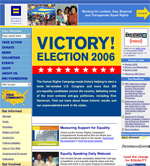 |
“VICTORY! Election 2006.” November 8, 2006. HRC Web site. [zoom] |